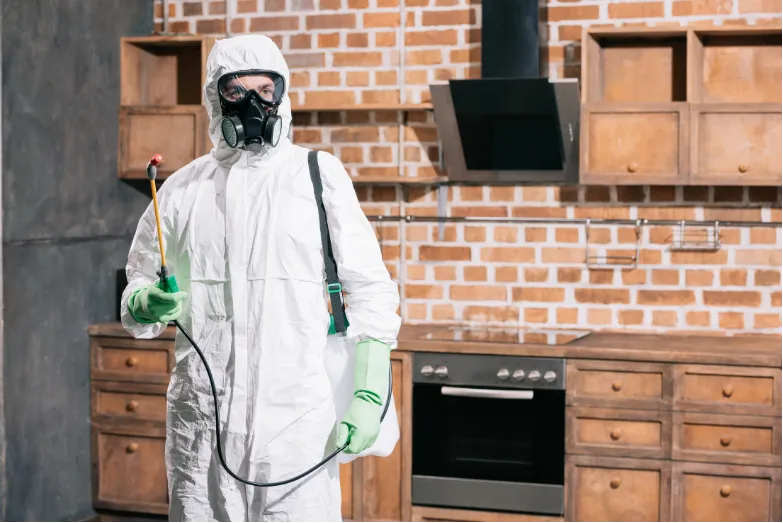

+1 (941) 475-9551
Neighborhood Pest Experts Since 1976. Safe, Reliable, Affordable Solutions You Can Trust.
For nearly 50 years, Ban-A-Bug has been keeping homes and businesses pest-free, season after season.
+1 (941) 259-1469
Neighborhood Pest Experts Since 1976. Safe, Reliable, Affordable Solutions You Can Trust.
For nearly 50 years, Ban-A-Bug has been keeping homes and businesses pest-free, season after season.
Find Out How Affordable Ban-A-Bug
Pest Protection Can Be!
Select a service below. If applicable, adjust your home size to see estimated pricing.
General Pest Control
Starting at $440 (Annual Plan)
Quarterly Pest Control
$120 Initial + $30/month
Mosquito Services
$95 Initial + $30/month
Rodent Control
Rodent Trapping Starting at $450 | Preventative: $35 one-time charge + $20/month
Bee Control
Starting at $270
Flea & Tick
Starting at $280
Your Complete Pest Control Starts with Ban-A-Bug
From detailed inspections to eco-conscious treatments, Ban-A-Bug delivers expert solutions that have kept homes safe since 1976.

Thorough Property Inspections
We find pest issues before they become major problems.

Eco-Friendly Treatments
Safe for your family, pets, and the environment.

Same-Day Service Available
Fast, effective solutions when you need them most

Personalized Pest Plans
Customized strategies for your unique home and needs.
Building Pest-Free Homes Since 1976: Discover Ban-A-Bug Excellence
At Ban-A-Bug, we do more than just eliminate pests. We create safe, healthy spaces for your family and business. For nearly 50 years, our expert team has delivered reliable, eco-friendly solutions that truly work.

Our Mission: Safe, Effective, and Eco-Friendly Solutions Since Day One
At Ban-A-Bug, we’re committed to more than pest control, we’re committed to peace of mind. Since 1976, we’ve focused on delivering effective, environmentally conscious treatments that keep your spaces safe and comfortable.
Our Approach: Customized Care for Every Home
Every property is unique, and so is our approach. We design personalized pest control strategies that deliver long-lasting protection while prioritizing the health and safety of your family and pets.
Why Choose Ban-A-Bug: Experience, Trust, and Local Expertise
With nearly 50 years in the industry, we combine proven methods with the latest technology to create tailored solutions that work and we’ve been doing it for generations of Florida families.

Our Mission: Safe, Effective, and Eco-Friendly Solutions Since Day One
At Ban-A-Bug, we’re committed to more than pest control, we’re committed to peace of mind. Since 1976, we’ve focused on delivering effective, environmentally conscious treatments that keep your spaces safe and comfortable.
Our Approach: Customized Care for Every Home
Every property is unique, and so is our approach. We design personalized pest control strategies that deliver long-lasting protection while prioritizing the health and safety of your family and pets.
Why Choose Ban-A-Bug: Experience, Trust, and Local Expertise
With nearly 50 years in the industry, we combine proven methods with the latest technology to create tailored solutions that work and we’ve been doing it for generations of Florida families.
- OUR SERVICES -
Complete Pest Control Solutions Designed for Your Home
At Ban-A-Bug, we understand every pest problem is different—and we’ve seen them all since 1976.
General Pest Control for Ants, Roaches & Spiders
Our general pest control service targets the most common household invaders, ensuring your home stays clean and comfortable. We use proven methods and eco-friendly solutions to eliminate pests and prevent future infestations.
Comprehensive treatment for ants, roaches, and spiders
Interior and exterior protection
Family- and pet-safe solutions
Preventative measures to reduce future infestations
Long-lasting pest prevention strategies
General Pest Control for Ants, Roaches & Spiders
Our general pest control service protects your home from everyday pests like ants, roaches, and spiders. We use safe, effective treatments that eliminate current infestations and keep pests from coming back.
Effective treatment for ants, roaches, and spiders
Complete interior and exterior coverage
Family- and pet-safe treatments
Preventative steps to stop future infestations
Long-term protection you can rely on
Rodent Control & Exclusion Services
Rodents cause damage and carry disease. Our team uses proven trapping, removal, and exclusion methods to keep your home safe—permanently.
Safe and effective rodent trapping
Sealing all entry points to block future invasions
Comprehensive inspection for hidden nesting spots
Discreet and professional rodent solutions
Preventative measures for long-term results
Rodent Control & Exclusion Services
Rodents can cause damage and spread disease. Our service combines trapping, removal, and exclusion techniques to keep rodents out of your home for good.
Humane and effective rodent trapping
Complete sealing of entry points to prevent return
Thorough inspection to identify nesting areas
Safe and discreet solutions for your property
Ongoing prevention strategies for lasting results
Mosquito, Flea & Tick Protection for Your Outdoor Spaces
Enjoy your outdoor spaces without bites or worries. Our mosquito, flea, and tick treatments protect your family and pets from harmful pests and the diseases they carry.
Powerful treatments for mosquitoes, fleas, and ticks
Full coverage for your yard, garden, and perimeter
Safe, eco-friendly solutions for your home
Seasonal service to maintain full protection
Helps prevent pest-borne diseases and allergies
Mosquito, Flea & Tick Control for Outdoor Protection
Keep your yard enjoyable and safe with our mosquito, flea, and tick treatments. We reduce these biting pests and protect your family and pets from harmful diseases.
Effective treatments for mosquitoes, fleas, and ticks
Yard, garden, and perimeter applications for full coverage
Eco-friendly and pet-safe treatment options
Seasonal maintenance for consistent protection
Reduces risk of pest-borne diseases and allergies
Professional Wasp & Hornet Nest Removal
Don’t risk painful stings. Let our experts handle wasp and hornet nests safely. We ensure complete removal to protect your family and property.
Fast and safe nest removal by professionals
Reduces risk of stings and allergic reactions
Specialized tools and protective gear for safety
Prevents nest regrowth in treated areas
Expert handling for minimal disruption to your property
Safe Wasp, Hornet & Bee Removal
Don’t risk a sting! Our experts handle wasp, hornet, and bee nests quickly and safely, protecting your family and property.
Quick, safe nest removal by trained pros
Protects against stings and allergic reactions
Uses specialized tools and protective gear
Stops nests from returning in treated areas
Professional service with minimal disruption
Quarterly Pest Control for Continuous Protection
Keep pests out all year long with our quarterly plan. Our scheduled treatments prevent infestations before they start.
Four treatments per year for consistent coverage
Prevents pest problems before they begin
Protects against most common household pests
Includes monitoring and necessary adjustments
Confidence knowing your home stays pest-free
Quarterly Pest Control for Year-Round Protection
Maintain a pest-free home all year with our quarterly preventative plan. Our seasonal treatments stop pests before they become a problem.
Four scheduled treatments for continuous protection
Stops infestations before they start
Covers a wide range of common household pests
Provides consistent monitoring and adjustments
Peace of mind knowing your home is always protected
- ABOUT US -
Protecting Homes Since 1976: The Ban-A-Bug Commitment to Quality
Ban-A-Bug has proudly served the community for nearly 50 years, delivering safe, effective, and eco-friendly pest control solutions. From Englewood to Venice and beyond, our mission is to protect your home and family with honesty, reliability, and proven results. We don’t just control pests. We build trust, offer education, and provide peace of mind that lasts for generations.

We stay ahead by using the latest pest control technologies and proven methods.
Every home is different, so we create fully customized treatment plans.
Your satisfaction matters most. We listen, advise, and address every concern.
Our commitment doesn’t end with one visit; we offer ongoing protection and support.
We believe education is key, so we help you prevent future infestations.
Our experienced team delivers reliable, professional service every single time.
- ABOUT US -
Protecting Homes Since 1976: The Ban-A-Bug Commitment to Quality
Ban-A-Bug has proudly served the community for nearly 50 years, delivering safe, effective, and eco-friendly pest control solutions. From Englewood to Venice and beyond, our mission is to protect your home and family with honesty, reliability, and proven results. We don’t just control pests. We build trust, offer education, and provide peace of mind that lasts for generations.

We stay ahead by using the latest pest control technologies and proven methods.
Every home is different, so we create fully customized treatment plans.
Your satisfaction matters most. We listen, advise, and address every concern.
Our commitment doesn’t end with one visit; we offer ongoing protection and support.
We believe education is key, so we help you prevent future infestations.
Our experienced team delivers reliable, professional service every single time.
Take the First Step Toward a Pest-Free Home!
Fill out our quick service request form and connect directly with the friendly Ban-A-Bug team. We’ll get back to you fast to schedule your customized pest control service.
Our Services Area
Ban-A-Bug proudly serves the following communities:
North Port
Punta Gorda
Port Charlotte
Placida
Boca Grande
Englewood
Venice
Osprey




Youtube

Tiktok

Copyrights 2025. Ban-A-Bug.
Terms and Conditions | Privacy Policy | All Rights Reserved

Copyrights 2025. Ban-A-Bug.
Terms and Conditions | Privacy Policy | All Rights Reserved



